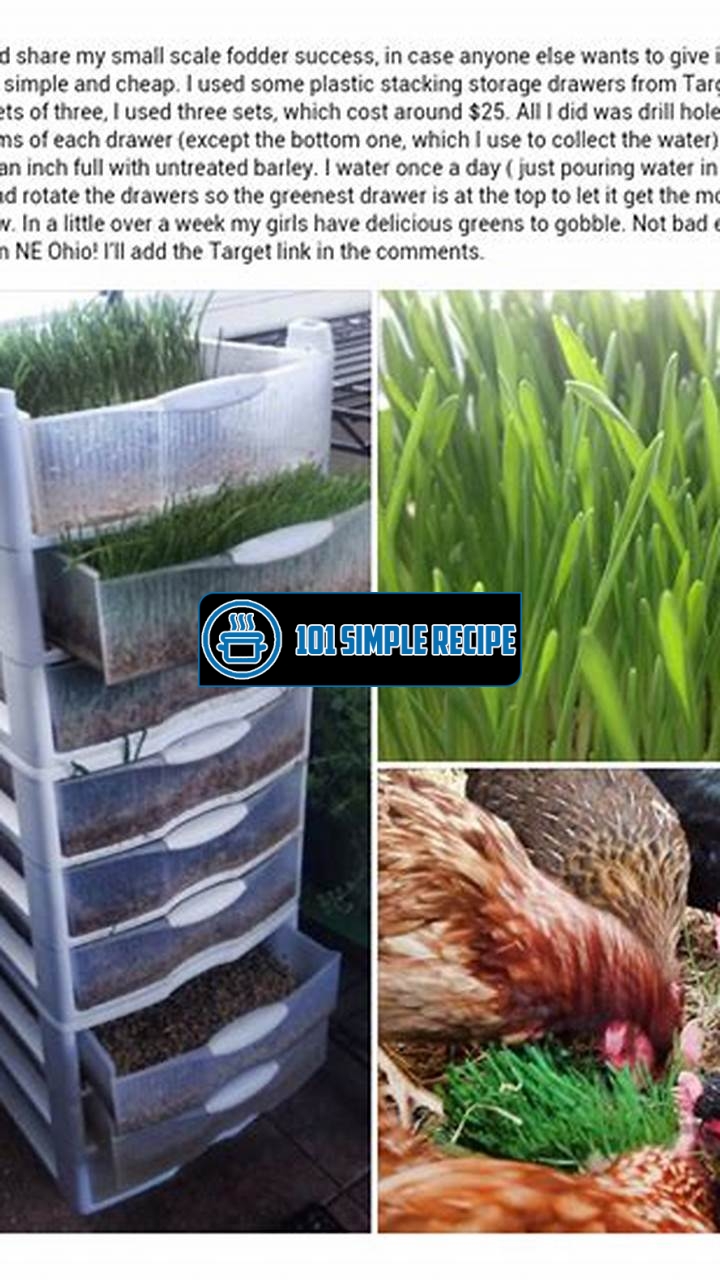Welcome to your guide on creating a step-by-step DIY fodder system for your chickens! In this article, we will walk you through the process of setting up a cost-effective and sustainable system that will provide your flock with nutritious and fresh feed year-round. By following these simple instructions, you can ensure that your chickens receive a constant supply of sprouted grains and green fodder, which will enhance their diet and overall health. So, let’s dive in and discover how you can easily create a flourishing fodder system for your feathered friends!

Benefits of a DIY Fodder System for Chickens
Discover the advantages of using a DIY fodder system to enhance the health and nutrition of your chickens.
Improved Nutritional Value
A DIY fodder system is a great way to provide your chickens with a highly nutritious food source. By growing your own fodder, you can ensure that your chickens are getting the freshest and most nutrient-rich feed possible.
When you sprout grains like barley, wheat, or alfalfa, they become highly digestible for chickens. This means that the nutrients in the grains are more easily absorbed and utilized by their bodies. Sprouted grains also contain higher levels of enzymes, vitamins, and minerals, which can help support the overall health and well-being of your chickens.
With a DIY fodder system, you have full control over the quality of the feed. You can choose organic grains and ensure that no harmful pesticides or chemicals are present in the feed. This results in a healthier diet for your chickens, which can lead to improved egg production, better feather quality, and overall stronger immune systems.
Note: Providing your chickens with a nutrient-dense feed can contribute to their overall health and productivity.
Cost Savings in Feed
One of the biggest advantages of a DIY fodder system is the potential cost savings in feed. Raising chickens can be expensive, particularly when it comes to purchasing feed. However, by growing your own fodder, you can significantly reduce your feed costs.
Grains used for sprouting are relatively inexpensive, and they can yield a large volume of fodder. For example, a pound of barley can grow up to 7-8 pounds of fodder. This means that you can produce a substantial amount of feed at a fraction of the cost of purchasing pre-made chicken feed.
Additionally, by growing your own fodder, you can reduce waste. Chickens tend to waste a fair amount of feed as they scratch and peck at it. With a DIY fodder system, you can ensure that your chickens are consuming the entire crop, minimizing waste and maximizing efficiency.
Note: A DIY fodder system can help save money on feed costs, allowing you to allocate your resources more efficiently.
Promotes Natural Foraging Behavior
Chickens are natural foragers, and a DIY fodder system can help promote and encourage this instinctive behavior. When you provide your chickens with fresh sprouted grains, they can spend time scratching, pecking, and searching for food, just as they would in the wild.
This natural foraging behavior not only provides mental stimulation for your chickens but also allows them to exercise and move around. As a result, they tend to be healthier, happier, and less prone to behavioral issues or boredom-related vices.
Moreover, when chickens forage for their own food, they are more likely to consume a diverse range of nutrients. By complementing their diet with sprouted grains, you can add variety to their feed and ensure they receive a well-rounded nutritional profile.
Note: A DIY fodder system encourages your chickens’ natural foraging behaviors, promoting physical and mental well-being.
In conclusion, a DIY fodder system offers numerous benefits for raising chickens. It provides improved nutritional value, cost savings in feed, and promotes natural foraging behavior. By implementing a DIY fodder system, you can enhance the health and well-being of your chickens while also saving money and fostering their innate instincts. So why not give it a try and see the positive impact it can have on your flock?
Setting Up Your DIY Fodder System
Creating a DIY fodder system for your chickens can be a rewarding and cost-effective way to provide them with nutritious greens throughout the year. By following a step-by-step process, you can set up your own system and ensure your feathered friends have access to fresh sprouted fodder. Let’s dive into the details!
Choosing the Right Seeds
The first crucial step in establishing your DIY fodder system is selecting the right seeds. Opt for high-quality, organic seeds that are suitable for sprouting. Popular choices include wheat, barley, oats, and maize. These seeds are readily available at local agricultural stores or online. Remember to choose seeds specifically meant for sprouting as other varieties may not produce the desired results.
Avoid seeds treated with chemicals or pesticides, as these can be harmful to your chickens. Additionally, consider incorporating a mix of seeds to provide a balanced diet and varied flavors for your feathered friends.
Preparing the Fodder Trays
Once you have your seeds, it’s time to prepare the fodder trays. Make sure you have enough trays to accommodate the needs of your flock. Each tray should be at least 2-3 inches deep and have drainage holes to prevent waterlogging.
Fill the trays with a layer of moistened organic soil or compost. This will provide the necessary nutrients for the sprouting and growth of the seeds. Spread a thin layer of seeds evenly over the soil, ensuring they are not overcrowded. Lightly press the seeds into the soil to ensure good contact.
Next, cover the seeds with a thin layer of organic mulch. This will help retain moisture and create a favorable environment for sprouting. Keep the trays in a warm, well-ventilated area. Ideal temperatures for sprouting are between 60-70°F (15-21°C).
Sprouting and Growing the Fodder
This is the stage where you’ll witness the magic of sprouting. After 24 hours, spray water over the seeds using a misting bottle. Keep the soil and seeds consistently moist throughout the sprouting process. Avoid overwatering, as it can lead to mold growth.
After a few days, tiny sprouts will start emerging from the seeds. At this point, provide indirect exposure to sunlight. Too much direct sunlight can cause the sprouts to dry out. Maintain a consistent watering schedule, ensuring the soil remains moist.
Within 7-10 days, the sprouts will reach an optimal height of 4-5 inches. At this stage, your chickens can start enjoying the fresh fodder. Cut the sprouts above the soil level, leaving the roots intact. Place the sprouts in their feeding area, and watch them happily peck away at the nutritious greens.
Note: It’s essential to continuously monitor the sprouts for any signs of mold or discoloration. If you notice any issues, simply discard the affected batch and start a fresh tray.
Regularly rotate the trays to ensure a continuous supply of fodder for your chickens. Start a new tray every 2-3 days to maintain a constant cycle of growth. With a little dedication and care, your DIY fodder system will provide your chickens with a steady source of nutrition and keep them healthy and happy.
So why wait? Get started on setting up your very own DIY fodder system today and give your chickens the gift of fresh, sprouted greens!
For a tasty and healthy option, try this weight loss recipe to help you reach your fitness goals.
Feeding Your Chickens with Fodder
Understanding how to properly incorporate fodder into your chickens’ diet is crucial for ensuring optimal health benefits. By following a step-by-step DIY fodder system, you can provide your chickens with a nutritious and sustainable food source. In this article, we will guide you through the process of introducing fodder to your chickens, monitoring and adjusting feeding amounts, and combining fodder with other feed sources.
Introducing Fodder to Your Chickens
When introducing fodder to your chickens, it is important to do so gradually. Start by offering small amounts of fodder alongside their regular feed. This allows them to get accustomed to the new food source and prevents any sudden dietary disruptions.
Monitor your chickens’ response to the fodder. Observe their eating patterns and ensure they are adjusting well to the new addition. It is also recommended to keep track of any changes in their overall health and egg production.
Remember to provide fresh water at all times. Fodder has a high moisture content, but chickens still require access to clean drinking water for proper hydration.
Monitoring and Adjusting Feeding Amounts
As you begin incorporating fodder into your chickens’ diet, it is essential to monitor their feeding amounts. Start by offering a small percentage, such as 10% of their daily feed, in the form of fodder. Observe how they respond and adjust the quantity accordingly.
Keep in mind that each chicken is unique, and their dietary needs may differ. Some chickens may require more fodder, while others may need less. Pay attention to their body condition and ensure they maintain a healthy weight. Adjust the feeding amounts accordingly to meet their individual needs.
Regularly evaluate the impact of the fodder on your chickens’ health. Look for signs of improved vitality, feather quality, and egg production. If you notice any negative effects or if your chickens are not consuming the fodder, reassess your approach and potentially consult with a poultry nutritionist for guidance.
Combining Fodder with Other Feed Sources
To provide a well-rounded diet for your chickens, it is important to combine fodder with other feed sources. This ensures they receive all the necessary nutrients for optimal health. You can continue to offer their regular feed, such as grains or pellets, alongside the fodder.
Additionally, consider incorporating kitchen scraps or garden trimmings into their diet. This adds variety and can further enhance their nutritional intake. However, remember to avoid feeding them any toxic or harmful substances, such as onion or avocado.
Regularly assess the balance between fodder and other feed sources. Adjust the proportions as needed based on your chickens’ response and nutritional requirements.
In conclusion, by understanding the proper way to incorporate fodder into your chickens’ diet, you can support their overall health and well-being. Gradually introduce fodder, monitor and adjust feeding amounts, and combine it with other feed sources for a balanced nutrition plan. By following these steps, you can create a sustainable and nutritious feeding system for your chickens.
If you’re hosting a party, don’t forget to try this punch bowl recipe to impress your guests.
Maintaining and Troubleshooting Your Fodder System
Discover essential tips for maintaining and addressing common issues with your DIY fodder system.
Cleaning and Sanitizing the Fodder Trays
To maintain a healthy and efficient fodder system for your chickens, it is crucial to regularly clean and sanitize the fodder trays. Cleaning the trays ensures that the sprouts remain free from contaminants, preventing any potential health issues for your chickens.
- Start by emptying the trays of any leftover sprouts or debris.
- Rinse the trays with water to remove any loose dirt or residue.
- Mix a solution of mild detergent and water, and scrub the trays thoroughly using a soft-bristle brush.
- Rinse the trays again to remove any soap residue.
- Sanitize the trays by spraying them with a diluted bleach solution or a natural disinfectant.
- Allow the trays to air dry completely before refilling them with fodder.
Note: Regular cleaning and sanitizing of the fodder trays will help promote a healthy environment for your chickens and prevent the growth of harmful bacteria.
Preventing Mold and Other Problems
Mold can be a common problem when growing fodder for chickens. However, by following some preventive measures, you can minimize the risk of mold growth and other potential problems.
- Ensure proper ventilation in the fodder room or area where the trays are kept. Good airflow helps prevent excess moisture, which can lead to mold growth.
- Monitor and maintain the temperature and humidity levels in the fodder room. Aim for a temperature range of around 70-75°F (21-24°C) and a humidity level of 50-65%.
- Regularly inspect the sprouts for any signs of mold or unusual discoloration. Remove any contaminated sprouts immediately to prevent further spread.
- Consider using a food-grade hydrogen peroxide solution as a natural disinfectant for the fodder trays. Dilute it according to the manufacturer’s instructions and spray it on the sprouts to inhibit mold growth.
- Properly store the seeds in a cool, dry place to maintain their viability and prevent the growth of mold or pests.
Note: Moldy sprouts can be toxic and harmful to chickens. Taking preventive measures and regularly monitoring the sprouts will help ensure the health and safety of your flock.
Expanding and Scaling Your Fodder System
If you find that your DIY fodder system is working well and you want to expand or scale it up, here are some tips to consider:
- Assess the available space and resources you have for expanding your system. Make sure you have enough room for additional trays and storage.
- Gradually increase the number of trays in your system to avoid overwhelming yourself or your chickens with a sudden influx of sprouts.
- Consider investing in automated systems or equipment to simplify the process of growing and feeding fodder to your chickens.
- Ensure proper management of water and nutrient supply as you expand. Monitor the watering schedule and adjust the nutrient ratios accordingly.
- Seek advice or guidance from experienced poultry farmers or other backyard chicken enthusiasts who have successfully scaled up their fodder systems.
Note: Scaling up your fodder system requires careful planning and consideration. It is essential to maintain a balance between the growth of your system and the needs of your chickens.
By following these maintenance tips and troubleshooting suggestions, you can keep your DIY fodder system for chickens running smoothly and provide your flock with nutritious sprouts to enhance their overall health and well-being.
Success Stories: Fodder Systems in Action
When it comes to providing optimal nutrition for your chickens, a DIY fodder system can be a game changer. Many chicken owners have shared their success stories after implementing this innovative approach to feeding their flocks. Let’s explore some of these real-life experiences that highlight the benefits and advantages of using a DIY fodder system for chickens.
Increased Egg Production and Quality
One of the most remarkable success stories involves the significant increase in egg production and improved quality. Chickens fed with fresh and nutritious fodder have been reported to lay more eggs than those on traditional diets. This can be attributed to the high nutrient content and bioavailability of the sprouted grains. Additionally, the vitamins and minerals found in the fodder contribute to stronger eggshells, resulting in a higher-quality product.
In fact, several chicken owners have witnessed a boost in their egg production by as much as 20% after introducing a DIY fodder system. This not only benefits them economically, but it also means a steady supply of fresh eggs for their households or businesses.
Healthier and Happier Chickens
The well-being of our chickens is always a top priority. With a DIY fodder system, you can ensure that your feathered friends are receiving a nutritionally balanced diet to promote their overall health and happiness.
Fodder sprouts are known to be rich in essential nutrients, including amino acids, vitamins, and minerals. These vital components contribute to better immune function, increased resistance to diseases, and improved feather quality. Chickens with access to a DIY fodder system have also demonstrated higher energy levels and improved digestion.
Many chicken owners have reported a noticeable decrease in health issues, such as feather pecking, mite infestations, and egg abnormalities, after incorporating a DIY fodder system into their feeding routine. This healthier and happier state of being translates to a more enjoyable chicken-keeping experience for both beginners and seasoned enthusiasts alike.
Testimonials from Fodder System Enthusiasts
Don’t just take our word for it! Listen to what other chicken owners, who have embraced DIY fodder systems, have to say about their experiences:
Martha from Oregon: “I started using a fodder system three months ago, and my chickens have never been happier! They are more active, have beautiful feathers, and are laying eggs like never before. It has truly transformed my small backyard flock.”
John from Texas: “As a sustainable farmer, I’m always looking for ways to improve efficiency and reduce costs. A DIY fodder system has been a game changer for me. Not only am I saving money on feed expenses, but my chickens are thriving and producing high-quality meat and eggs. It’s a win-win!”
These testimonials are just a glimpse into the positive impact that a DIY fodder system can have on your chickens and your overall poultry-raising experience. By providing your flock with fresh and nutritious sprouted grains, you’ll witness a significant improvement in egg production, quality, and the overall health and happiness of your chickens.
If you’re interested in other recipes, you can check out this White Castle recipe for a delicious fast food treat.
Frequently Asked Questions
Here are some frequently asked questions about building a DIY fodder system for chickens:
| No. | Questions | Answers |
|---|---|---|
| 1. | What is a DIY fodder system? | A DIY fodder system is a method of growing fresh, nutritious fodder for chickens in a cost-effective and sustainable way. It involves sprouting grains and legumes to provide a highly nutritious feed source. |
| 2. | Why should I consider a DIY fodder system for my chickens? | A DIY fodder system allows you to provide your chickens with a fresh and nutrient-dense feed source. It can help reduce feed costs and improve the overall health and productivity of your flock. |
| 3. | What materials do I need to build a DIY fodder system? | To build a DIY fodder system, you will need trays or containers, seeds for sprouting, water, and a suitable space with proper lighting and ventilation. |
| 4. | How do I sprout grains and legumes for my DIY fodder system? | To sprout grains and legumes, soak them in water overnight, then rinse and drain them twice a day. Keep them in a tray or container and provide indirect sunlight. Within a few days, you will have sprouted fodder ready to feed to your chickens. |
| 5. | Can I use any type of seeds for my DIY fodder system? | You can use a variety of seeds for your DIY fodder system, including wheat, barley, oats, and legumes like alfalfa and lentils. Experiment with different seeds to find what works best for your chickens. |
| 6. | How often should I feed my chickens with the sprouted fodder? | You can feed your chickens the sprouted fodder daily or a few times a week, depending on their nutritional needs and the amount of fodder you are able to produce. Monitor their intake and adjust accordingly. |
Thank You for Reading!
We hope you found this article on building a DIY fodder system for chickens informative and inspiring. By implementing this cost-effective and nutritious feeding method, you can enhance the health and productivity of your flock while reducing feed costs. Remember to check back for more valuable tips and tricks for raising happy and healthy chickens!
Jump to Recipe
DIY Fodder System for Chickens

Learn how to build a DIY fodder system to provide fresh and nutritious feed for your chickens.
- Wheat seeds
- Barley seeds
- Oats seeds
- Soak the seeds in water overnight.
- Rinse the soaked seeds and drain them twice a day.
- Place the seeds in a tray or container and provide indirect sunlight.
- Within a few days, the seeds will sprout. Harvest the sprouts and feed them to your chickens.






